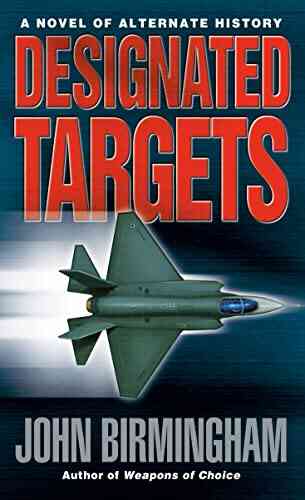The Development Of Marine Corps Amphibious Doctrine 1898-1941


In the realm of military strategy, the ability to conduct amphibious operations has always been a crucial factor. From the early days of sailing and naval warfare to the modern era, the Marine Corps has played a significant role in developing and refining amphibious doctrines. This article explores the fascinating journey of the Marine Corps' development of amphibious doctrine from 1898 to 1941, tracing the key milestones and strategic transformations that shaped their approach.
From Expeditionary Forces to World War I
The roots of the Marine Corps' amphibious doctrine can be traced back to the late 19th century. In 1898, the Marine Corps made its first significant amphibious assault in the Battle of Guantánamo Bay during the Spanish-American War. This crucial operation laid the foundation for future amphibious strategies.
During World War I, the Marine Corps further refined its amphibious capabilities. With the advent of tanks, aircraft, and other innovations, the Marines became adept at conducting combined arms operations from ship to shore. The Battle of Belleau Wood in 1918 showcased the Corps' ability to adapt and succeed in challenging amphibious environments.
4 out of 5
| Language | : | English |
| File size | : | 1873 KB |
| Text-to-Speech | : | Enabled |
| Enhanced typesetting | : | Enabled |
| Word Wise | : | Enabled |
| Print length | : | 21 pages |
| Lending | : | Enabled |
| Screen Reader | : | Supported |
The Interwar Period: Experimentation and Learning
In the interwar period, the Marine Corps focused on experimentation and learning from previous experiences. The Lessons Learned from the Vera Cruz Intervention in 1914 and subsequent operations in Haiti and the Dominican Republic provided valuable insights into the challenges of amphibious warfare.
Under the leadership of Lieutenant Colonel Earl "Pete" Ellis, the Marine Corps conducted extensive studies and developed new doctrines. Ellis emphasized the use of mobile and flexible forces, combined arms, and close air support in amphibious operations. His work laid the groundwork for future amphibious campaigns.
World War II: The Pacific Theater
The outbreak of World War II marked a turning point in the development of Marine Corps amphibious doctrine. The Pacific Theater became the ultimate testing ground for the Corps' amphibious capabilities.
The Battle of Guadalcanal in 1942 was a watershed moment, highlighting the importance of amphibious assaults for securing strategic objectives. The Marines' successful operations in Guadalcanal and subsequent campaigns such as Tarawa, Iwo Jima, and Okinawa demonstrated the effectiveness of their evolving doctrine.
Key Principles and Innovations
Throughout this period, several key principles and innovations emerged that shaped Marine Corps amphibious doctrine:
- The emphasis on thorough intelligence, reconnaissance, and planning to ensure effective and successful landings
- The development of specialized landing craft and amphibious vehicles for transporting troops and equipment
- The integration of naval and air support to provide cover, suppress enemy defenses, and facilitate the landing
- The use of combined arms tactics, with Marines incorporating infantry, artillery, armor, and aviation elements
- The establishment of the Marine Corps Schools, which formalized the training and education of amphibious specialists
Legacy and Influence
The development of Marine Corps amphibious doctrine from 1898 to 1941 has left a lasting legacy and continues to shape military operations worldwide. The lessons learned during this period have been instrumental in the success of subsequent amphibious campaigns, such as the D-Day landings during World War II and the Incheon landings during the Korean War.
Today, the Marine Corps' commitment to amphibious warfare remains steadfast, with ongoing adaptations and refinements to doctrine and strategies. The ability to project power from the sea to the shore continues to be a crucial capability in modern warfare scenarios.
The Marine Corps' development of amphibious doctrine from 1898 to 1941 represents a remarkable journey of innovation, adaptation, and strategic refinement. From the initial engagements in the Spanish-American War to the pivotal battles of World War II, the Marines have continuously improved their amphibious capabilities.
The lessons learned from this period, combined with ongoing advancements, have ensured the Marine Corps' position as a leading force in amphibious warfare. As technology and tactics evolve, the Marine Corps continues to adapt and expand its capabilities, ensuring its readiness to face the challenges of the future.
4 out of 5
| Language | : | English |
| File size | : | 1873 KB |
| Text-to-Speech | : | Enabled |
| Enhanced typesetting | : | Enabled |
| Word Wise | : | Enabled |
| Print length | : | 21 pages |
| Lending | : | Enabled |
| Screen Reader | : | Supported |
Land the Landing Force
The Development of U.S. Marine Corps Amphibious Doctrine
1898–1941
Eric Hammel
For the first 123 years of its existence, the United States Marine Corps was, like its British parent, the Royal Marines, a branch of the navy composed of small, ship-board detachments that usually served as seagoing police or base guards but were sometimes employed as the core of detachments that boarded enemy ships or took part in brief forays to attack enemy ports and fortresses. This changed in 1898, when at Key West, at the start of the Spanish–American War, the Marine Corps organized and trained an expeditionary battalion of infantry and artillery to seize—and hold—a beachhead at Guantánamo Bay, Cuba. On May 10, 1898—just ten days ahead of a landing by the main U.S. Army invasion force—the Marine expeditionary battalion secured the objective, which it then successfully defended against a superior Spanish force.
The use of amphibiously delivered Marines to seize an advance base and to defend it was revolutionary.
Now, in a 4,500-word essay, military historian Eric Hammel chronicles the evolution of the Fleet Marine Force and its amphibious tactics between 1898 and the eve of America’s entry into World War II.
Do you want to contribute by writing guest posts on this blog?
Please contact us and send us a resume of previous articles that you have written.




















Light bulbAdvertise smarter! Our strategic ad space ensures maximum exposure. Reserve your spot today!

 Gabriel HayesCaught You Rylie Wolf: An FBI Suspense Thriller Two - Unveiling Secrets of...
Gabriel HayesCaught You Rylie Wolf: An FBI Suspense Thriller Two - Unveiling Secrets of...
 Benjamin StoneThe Thrilling Backwater Predator: Join Kurt Hunter in His 11th Mysteries...
Benjamin StoneThe Thrilling Backwater Predator: Join Kurt Hunter in His 11th Mysteries... Aleksandr PushkinFollow ·18.2k
Aleksandr PushkinFollow ·18.2k Ryan FosterFollow ·4.7k
Ryan FosterFollow ·4.7k Ryūnosuke AkutagawaFollow ·5.1k
Ryūnosuke AkutagawaFollow ·5.1k Adrian WardFollow ·12.3k
Adrian WardFollow ·12.3k Shawn ReedFollow ·7.3k
Shawn ReedFollow ·7.3k Marcel ProustFollow ·15.5k
Marcel ProustFollow ·15.5k Robert FrostFollow ·17.4k
Robert FrostFollow ·17.4k Vince HayesFollow ·9.8k
Vince HayesFollow ·9.8k

 Brian West
Brian WestTaking Pride Maria Baes: Embracing Individuality and...
When it comes to self-expression and...

 Gordon Cox
Gordon CoxThe Red Well Western Trio: Experience the Authentic Wild...
Are you looking for an exhilarating escape...

 Kyle Powell
Kyle PowellThe Mesmerizing Colors of Black Hills Fall: Experience...
As the warm days of summer fade away,...

 J.D. Salinger
J.D. SalingerNo Romance Nhb Modern Plays: An Unconventional...
Love has always been a predominant theme...

 Ernest J. Gaines
Ernest J. GainesShunned Seal Team Disavowed: Unraveling the Secrets of...
When it comes to the...

 Colt Simmons
Colt SimmonsThe Enthralling Journey of Grimstone Croft and Wesson...
Are you ready to embark on an extraordinary...

 Harry Cook
Harry CookMarried Struggle Varsity - Unlocking the Secrets for a...
Marriage is a beautiful journey...

 Douglas Powell
Douglas PowellDragons Vs Elves Vs Humans Coming Of Age Fantasy Beyond...
Once upon a time, in a realm beyond our...

 Ted Simmons
Ted SimmonsOfficial Game Guide Updated For Mass Effect Final Version
Mass Effect, the...

 Marc Foster
Marc FosterThe Mistborn Saga: Journey into a World of Magic,...
Welcome to the enchanting...

 Al Foster
Al FosterThe True Story of Injustice in the American South: A Tale...
From the pages of history, we uncover a...

 Vince Hayes
Vince HayesDiscover the Incredible Awakening to a New Worldview and...
Have you ever found yourself questioning the...
4 out of 5
| Language | : | English |
| File size | : | 1873 KB |
| Text-to-Speech | : | Enabled |
| Enhanced typesetting | : | Enabled |
| Word Wise | : | Enabled |
| Print length | : | 21 pages |
| Lending | : | Enabled |
| Screen Reader | : | Supported |
















